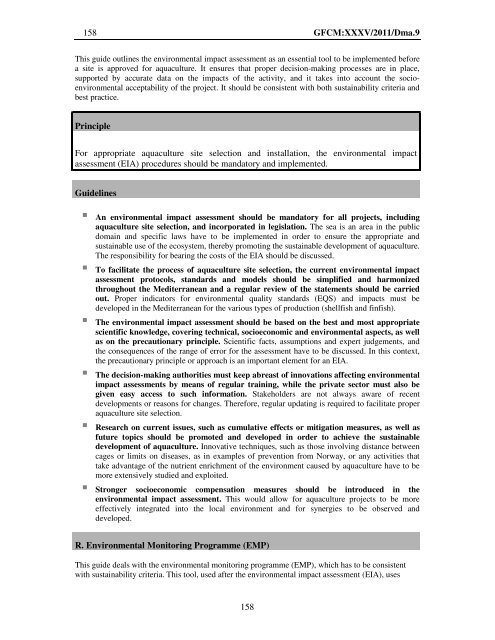Site selection and carrying capacity in Mediterranean ... - FAO Sipam
Site selection and carrying capacity in Mediterranean ... - FAO Sipam
Site selection and carrying capacity in Mediterranean ... - FAO Sipam
You also want an ePaper? Increase the reach of your titles
YUMPU automatically turns print PDFs into web optimized ePapers that Google loves.
158 GFCM:XXXV/2011/Dma.9<br />
This guide outl<strong>in</strong>es the environmental impact assessment as an essential tool to be implemented before<br />
a site is approved for aquaculture. It ensures that proper decision-mak<strong>in</strong>g processes are <strong>in</strong> place,<br />
supported by accurate data on the impacts of the activity, <strong>and</strong> it takes <strong>in</strong>to account the socioenvironmental<br />
acceptability of the project. It should be consistent with both susta<strong>in</strong>ability criteria <strong>and</strong><br />
best practice.<br />
Pr<strong>in</strong>ciple<br />
For appropriate aquaculture site <strong>selection</strong> <strong>and</strong> <strong>in</strong>stallation, the environmental impact<br />
assessment (EIA) procedures should be m<strong>and</strong>atory <strong>and</strong> implemented.<br />
Guidel<strong>in</strong>es<br />
An environmental impact assessment should be m<strong>and</strong>atory for all projects, <strong>in</strong>clud<strong>in</strong>g<br />
aquaculture site <strong>selection</strong>, <strong>and</strong> <strong>in</strong>corporated <strong>in</strong> legislation. The sea is an area <strong>in</strong> the public<br />
doma<strong>in</strong> <strong>and</strong> specific laws have to be implemented <strong>in</strong> order to ensure the appropriate <strong>and</strong><br />
susta<strong>in</strong>able use of the ecosystem, thereby promot<strong>in</strong>g the susta<strong>in</strong>able development of aquaculture.<br />
The responsibility for bear<strong>in</strong>g the costs of the EIA should be discussed.<br />
To facilitate the process of aquaculture site <strong>selection</strong>, the current environmental impact<br />
assessment protocols, st<strong>and</strong>ards <strong>and</strong> models should be simplified <strong>and</strong> harmonized<br />
throughout the <strong>Mediterranean</strong> <strong>and</strong> a regular review of the statements should be carried<br />
out. Proper <strong>in</strong>dicators for environmental quality st<strong>and</strong>ards (EQS) <strong>and</strong> impacts must be<br />
developed <strong>in</strong> the <strong>Mediterranean</strong> for the various types of production (shellfish <strong>and</strong> f<strong>in</strong>fish).<br />
The environmental impact assessment should be based on the best <strong>and</strong> most appropriate<br />
scientific knowledge, cover<strong>in</strong>g technical, socioeconomic <strong>and</strong> environmental aspects, as well<br />
as on the precautionary pr<strong>in</strong>ciple. Scientific facts, assumptions <strong>and</strong> expert judgements, <strong>and</strong><br />
the consequences of the range of error for the assessment have to be discussed. In this context,<br />
the precautionary pr<strong>in</strong>ciple or approach is an important element for an EIA.<br />
The decision-mak<strong>in</strong>g authorities must keep abreast of <strong>in</strong>novations affect<strong>in</strong>g environmental<br />
impact assessments by means of regular tra<strong>in</strong><strong>in</strong>g, while the private sector must also be<br />
given easy access to such <strong>in</strong>formation. Stakeholders are not always aware of recent<br />
developments or reasons for changes. Therefore, regular updat<strong>in</strong>g is required to facilitate proper<br />
aquaculture site <strong>selection</strong>.<br />
Research on current issues, such as cumulative effects or mitigation measures, as well as<br />
future topics should be promoted <strong>and</strong> developed <strong>in</strong> order to achieve the susta<strong>in</strong>able<br />
development of aquaculture. Innovative techniques, such as those <strong>in</strong>volv<strong>in</strong>g distance between<br />
cages or limits on diseases, as <strong>in</strong> examples of prevention from Norway, or any activities that<br />
take advantage of the nutrient enrichment of the environment caused by aquaculture have to be<br />
more extensively studied <strong>and</strong> exploited.<br />
Stronger socioeconomic compensation measures should be <strong>in</strong>troduced <strong>in</strong> the<br />
environmental impact assessment. This would allow for aquaculture projects to be more<br />
effectively <strong>in</strong>tegrated <strong>in</strong>to the local environment <strong>and</strong> for synergies to be observed <strong>and</strong><br />
developed.<br />
R. Environmental Monitor<strong>in</strong>g Programme (EMP)<br />
This guide deals with the environmental monitor<strong>in</strong>g programme (EMP), which has to be consistent<br />
with susta<strong>in</strong>ability criteria. This tool, used after the environmental impact assessment (EIA), uses<br />
158
















